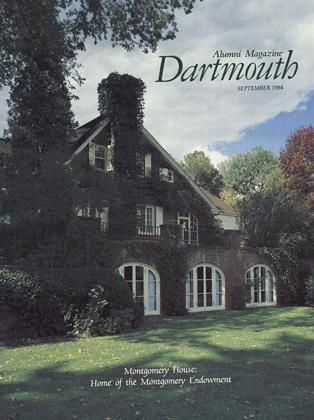The relocation in late June of the sculpture X-Delta from in front of Sanborn House its home of eight years to a new site just west of the Sphinx Senior Society has evoked a myriad of emotions around campus.
Janice Wright, administrative assistant in the English department, said she misses seeing the young children playing on the sculpture's swing outside the window of her Sanborn House office. But William Smith, director of OISER, said he was glad X-Delta had been moved away from its site close to his Webster Hall office since it was never pleasing to his eye. Such is the clash of opinions that has continually surrounded sculptor Mark di Suvero's X-Delta since it was donated to the College in 1976 by Kent Klineman '54.
The piece's artistic significance is almost beyond debate. Professor of Art Robert McGrath called di Suvero "one of the most important living American sculptors ... an established master of the abstract field." He added, "Anyone who has trouble with di Suvero's work really has trouble with modern art." Jacquelynn Baas, chief curator and acting director of the Hood Museum of Art, called X-Delta "Dartmouth's most important work of outside sculpture." The debate over the piece centers on where on campus the 18-foot-high steel sculpture belongs.
Peter Smith, former director of the Hopkins Center and a member of the committee that placed the piece in the spot between Sanborn and the Green, said the original siting produced a good deal of controversy. In view of X-Delta's importance, Smith said, the committee chose the Sanborn site "to put it in the most prominent place on campus . . . such a major piece deserves that type of prominence."
Provost Agnar Pytte said that since X-Delta's original siting, there has been a "steady correspondence over the years" concerning the sculpture. The letters from people on campus, alumni, and others ranged, he said, "from those who loved it ... to others who didn't like it and wanted it moved."
The College's Design Review Committee, which is charged with watching over "the overall ambiance of the campus," began to consider a relocation of the sculpture last year upon suggestions from both within and without the committee. A statement issued July 2 on behalf of the Design Review Committee said that body had decided unanimously that the new location on the wooded slope near the intersection of East Wheelock and Crosby streets, across from the planned new athletic center, "would be a superb new location for X-Delta... [which] would provide, to a high degree, an appropriate all-seasons display and appreciation and enjoyment of this fine work of art."
McGrath, who is a member of the Design Review Committee, said, "I happen to prefer the new site.... I always felt there was a clash [at the Sanborn site] between the Green and the buildings and the piece,'"resulting in both X-Delta and its suroundings "being diminished."
One of McGrath's colleagues, Jim Jordan, chairman of the art history department, disagrees. "I think it was a big mistake to move X-Delta from the Sanborn site to this obscure position away from the center of campus," he said. His feeling is based on both aesthetic and educational factors. On aesthetic grounds, he saw the former site as "interesting, challenging, appropriate" and "a juxtaposition of old geometry with new geometry." He called X-Delta "one of the best pieces outside the Orozco that we own" and said, "It looks less than positive to shunt it off to the woods." On educational grounds, he said the sculpture in its former, prominent site "stimulated discussion" and was "a good first lesson in public art" for students. "It seems virtually hidden," he said of the new site. "A comparative minority of students can see it there. I would hope it would eventually be moved back to Sanborn," he concluded.
Marianne Alverson, administrative assistant in the Asian Studies program, is one observer whose reactions to X-Delta have run the full gamut. She was at first critical of the Sanborn location, but now is an advocate of returning the piece to the old spot. In fact, Alverson staged a "spontaneous sit-in" at the new site, when she saw the sculpture being moved, to question why it was being moved. "Was it an educational and artistic decision?" she wondered, then added, "The more I've heard I don't think that's the case."
Pytte said, as did others, that while there are no immediate plans for another move of the sculpture, the new site, like the Sanborn one, is not necessarily an entirely permanent one. He added, "There are certainly a lot of kids swinging on it in the new location."
Marianne Alverson, an administrative assistant in the Asian Studies program, staged a "spontaneous sit-in" when she saw the sculpture X-Delta being moved from its former site on the lawn of Sanborn House to this wooded slope next to Sphinx.
 View Full Issue
View Full Issue
More From This Issue
-
 Feature
FeatureDennis Brutus Speaks Out
September 1984 By Kendal Price '78 -
 Cover Story
Cover StoryThe Montgomery Endowment Finds a Home
September 1984 By Shelby Grantham -
 Feature
FeatureRichard Eberhart at Eighty: The Long Reach of Talent
September 1984 By Jay Parini -
 Feature
Feature"Three ... Forty-two ... Hut"
September 1984 By Jim Kenyon -
 Feature
Feature"Innocent Ardor and Delight": A Tribute to Richard Eberhart
September 1984 By James Melville Cox -
 Article
ArticleRumblings On Fraternity Row
September 1984 By Fred Pfaff '85
Article
-
 Article
ArticleRESOLUTION OF THE FACULTY
January, 1914 -
 Article
Article"Ecstasy" Blows Fuse
June 1940 -
 Article
ArticleFaculty Articles
July 1961 -
 Article
ArticleBASKETBALL
APRIL 1969 By JACK DE GANGE -
 Article
ArticleWas It Medford Rum?
December 1959 By JAMES H. MOGOWAN '17 -
 Article
ArticleTotems, taboos . . and Opportunities
NOVEMBER 1963 By William Slade Backer '64


